Experiencing pregnancy at an advanced maternal age in a private hospital
DOI:
https://doi.org/10.15253/2175-6783.20222370958Keywords:
Obstetric Nursing; Maternal Age; Pregnancy, High-Risk; Women’s Health.Abstract
Objective: to describe the experiences of pregnant women at advanced maternal age assisted in a private hospital. Methods: a qualitative study, carried out with 17 women, by means of semi-structured interviews via telephone. The data was submitted to Thematic Content Analysis. Results: the participants were between 35 and 40 years old. Two categories emerged: Experiencing pregnancy as a couple and family: the preparation of the couple for pregnancy and childbirth (Pregnancy after 35 years old as an element of potentiality; Change in the family routine for the baby’s arrival) and Experiencing pregnancy and its changes: perceiving pregnancy as a healthy and calm experience (Change in emotional patterns related to the pregnancy process). Conclusion: experiencing pregnancy late in life was not a concern for women. Maturity and favorable socioeconomic conditions may have a protective influence on the course of healthy pregnancies in women attending the private health service.
Downloads
References
Fitzpatrick KE, Tuffnell D, Kurinczuk JJ, Knight M. Pregnancy at very advanced maternal age: a UK population‐based cohort study. BJOG. 2016; 124(7):1097-106. doi: https://doi.org/10.1111/1471-0528.14269
Fundo de População das Nações Unidas no Brasil. Fecundidade e dinâmica da população brasileira [Internet]. 2018 [cited Apr 13, 2021]. Available form:https://brazil.unfpa.org/sites/default/files/pub-pdf/sumario_executivo_br_0.pdf
Aldrighi JD, Wall ML, Souza S. Experience of pregnant women at an advanced age. Rev Gaúcha Enferm. 2018; 39:e20170112. doi: https://doi.org/10.1590/1983-1447.2018.2017-0112
Nottingham-Jones J, Simmonds JG, Snell TL. First-time mothers’ experiences of preparing for childbirth at advanced maternal age. Midwifery. 2020; 86:102558. doi: https://doi.org/10.1016/j.midw.2019.102558
Maloney SI, Abresch C, Grimm B, Lyons K, Tibbits M. Factors associated with giving birth at advanced maternal age in the United States. Midwifery. 2021; 98:102975. doi: https://doi.org/10.1016/j.midw.2021.102975
Aldrighi JD, Wall ML, Souza SR, Cancela FZ. The experiences of pregnant women at an advanced maternal age: an integrative review. Rev Esc Enferm USP. 2016; 50(3):512-21. doi: https://doi.org/10.1590/S0080-623420160000400019
Laopaiboon M, Lumbiganon P, Intarut N, Mori R, Ganchimeg T, Vogel JP, et al. Advanced maternal age and pregnancy outcomes: a multicountry assessment. BJOG. 2014; 121(Suppl 1):49-56. doi: https://doi.org/10.1111/1471-0528.12659
Ministério da Saúde (BR). Departamento de Informática do Sistema Único de Saúde (DATASUS). Sistema de Informações de Nascidos Vivos. Número de nascidos vivos conforme a idade materna 2010-2019 [Internet]. 2021 [cited Apr 13, 2021]. Available from: http://tabnet.datasus.gov.br/cgi/deftohtm.exe?sinasc/cnv/nvuf.def
Creswell JW. Investigação qualitativa e projeto de pesquisa: escolhendo entre cinco abordagens. Porto Alegre: Penso; 2014.
Camargo BV, Justo AM. Tutorial para uso do software IRAMUTEQ [Internet]. 2018 [cited Jun 18, 2021]. Available from: http://www.iramuteq.org/documentation/fichiers/tutoriel-portugais-22-11-2018
Southby C, Cooke A, Lavender T. “It’s now or never” – nulliparous women’s experiences of pregnancy at advanced maternal age: a grounded theory study. Midwifery. 2019; 68:1-8. doi: https://doi.org/10.1016/j.midw.2018.09.006
Medeiros FF, Santos IDL, Ferrari RAP, Serafim D, Maciel SM, Cardelli AAM. Prenatal follow-up of high-risk pregnancy in the public service. Rev Bras Enferm. 2019; 72(suppl 3):204-11. doi: http://dx.doi.org/10.1590/0034-7167-2018-0425
Marques B, Palha F, Moreira E, Valente S, Abrantes M, Saldanha J. Being a mother after 35 years: will it be different? Acta Med Port. 2017; 30(9):615-22. doi: https://doi.org/10.20344/amp.8319
Padilha T, Sanches MA. Participação masculina no planejamento familiar: revisão integrativa da literatura. Interface. 2020; 24:e200047. doi: http://dx.doi.org/10.1590/interface.200047
Haakstad LAH, Voldner N, Bø K. Pregnancy and advanced maternal age – the associations between regular exercise and maternal and newborn health variables. Acta Obstet Gynecol Scand. 2020; 99(2):240-8. doi: https://doi.org/10.1111/aogs.13738
Errico LSP, Bicalho PG, Oliveira T, Martins EF. The work of nurses in high-risk prenatal care from the perspective of basic human needs. Rev Bras Enferm. 2018; 71(suppl 3):1257-64. doi: https://doi.org/10.1590/0034-7167-2017-0328
Kołomańska D, Zarawski M, Mazur-Bialy A. Physical activity and depressive disorders in pregnant women – a systematic review. Medicina (Kaunas). 2019; 55(5):212. doi: https://doi.org/10.3390/medicina55050212
Brunton R, Simpson N, Dryer R. Pregnancy-related anxiety, perceived parental self-efficacy and the influence of parity and age. Int J Environ Res Public Health. 2020; 17(18):6709. doi: https://doi.org/10.3390/ijerph17186709
Downloads
Published
How to Cite
Issue
Section
License
Copyright (c) 2022 Rev Rene

This work is licensed under a Creative Commons Attribution 4.0 International License.









